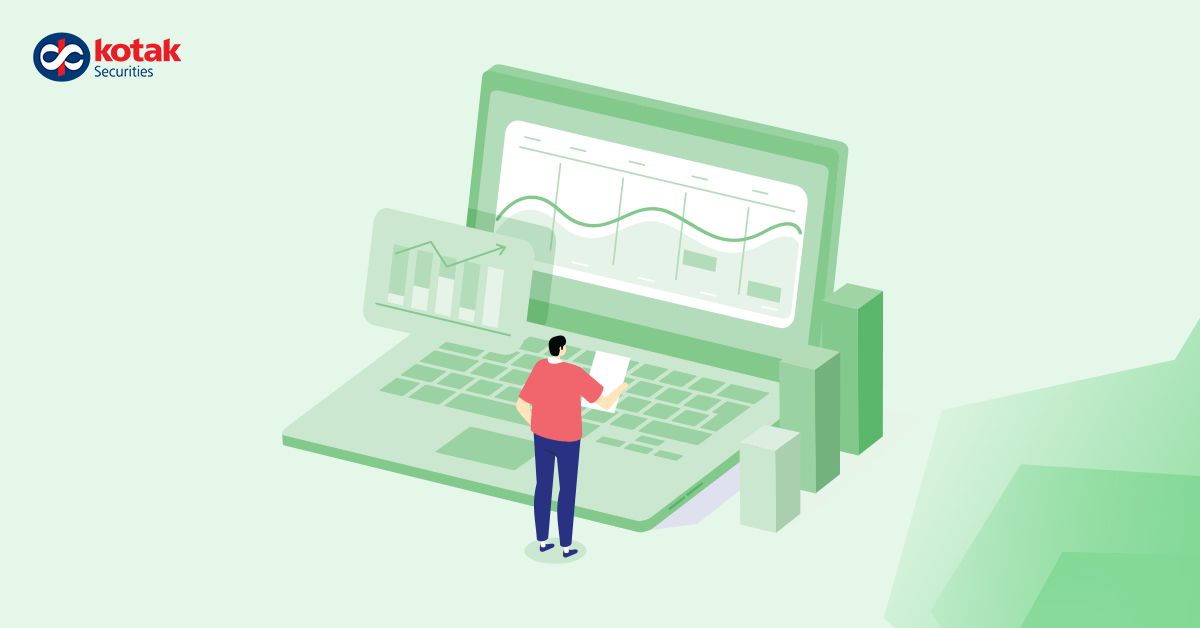Intraday Trading Guide For Beginners
Intraday trading, also called day trading, is the buying and selling of stocks within the same day. In other words, intraday trading means all positions are squared off before the market closes, and there is no change in ownership of shares as a result of the trades.
Until recently, people perceived day trading to be the domain of financial firms and professional traders. But this has changed today, thanks to the popularity of electronic trading and margin trading. Today, it’s very easy to start day trading. Let us explain how it works to help you get started.
How does intraday trading work?
In intraday trading, traders try to capitalise on short-term price fluctuations and generate profits based on market volatility. Intraday traders closely monitor price movements, utilise technical analysis tools, and employ strategies like scalping or momentum trading to execute quick trades and take advantage of intraday price swings. It requires careful risk management, market knowledge, and the ability to make swift decisions in a fast-paced trading environment.
Benefits of intraday trading
Intraday trading offers several benefits for traders:
1. Quick profits: Intraday trading allows traders to capitalise on short-term price movements, potentially generating quick profits within a single trading day.
2. Increased liquidity: Intraday trading provides numerous trading opportunities as financial markets tend to be more liquid during trading hours, allowing traders to easily enter and exit positions.
3. Flexibility: Intraday trading offers flexibility in terms of strategy and trading style. Traders can choose from a variety of techniques, such as scalping, momentum trading, or technical analysis-based approaches.
4. Lower overnight risks: By closing all positions before the market closes, intraday traders can mitigate the risks associated with overnight market events, such as company announcements or global news that could impact prices.
5. Learning opportunities: Intraday trading allows traders to gain practical experience and learn about market dynamics, technical analysis, and risk management strategies through real-time trading activities.
Advantages & disadvantages of intraday trading
Before you understand how to do intraday trading, it is important to understand its advantages and disadvantages.
Advantages: Intraday trading offers the potential for quick profits as traders can take advantage of short-term price movements. It provides numerous trading opportunities within a single day, allowing for increased liquidity and flexibility. Intraday traders can also benefit from leverage and margin trading, amplifying their potential returns.
Disadvantages: Intraday trading carries inherent risks. The fast-paced nature of intraday trading can lead to emotional decision-making and impulsive trades, increasing the likelihood of losses. Traders need to closely monitor the market throughout the day, requiring significant time and attention. Intraday trading also requires a deep understanding of technical analysis and market dynamics, which may pose a challenge for novice traders. Additionally, transaction costs, such as brokerage fees and taxes, can erode profits, particularly for frequent traders.
How is intraday trading different from regular trading?
There's only one difference between a regular trade and an intraday trade. It lies in taking the delivery of the stocks. In intraday trading, you square off your positions on the same day. So, your sell order offsets your buy order. This way, there is no transfer of ownership of shares. A regular trade gets settled over a span of days, if not longer. So, you get delivery of the shares you bought while the shares you sold move out of your Demat account.
Basic rules for intraday trading
Trading of any kind has its own set of rules. Here are the basic rules that every intraday trader needs to keep in mind.
-
Do Your Research: Do a thorough research and analysis about the current market situation, learn the fundamentals of the companies being traded, and gain knowledge of macroeconomic details, such as the country’s debt status or currency movements.
-
Invest An Amount You're Not Afraid To Lose: Intraday trading is high-risk. It is advisable you only invest what you can afford to lose.
-
Understanding Entry, Exit And Stop Price Settings: Selecting the right value for entry and exit is crucial. This helps in setting an escape value for a crisis situation.
-
Do Not Overtrade: The share market does not necessarily trend in a predictable manner. The optimal way to go about intraday trading is to trade only a handful of scrips at a time.
-
Evaluate Your Performance: Intraday trading is dynamic. Keeping a track of your performance will help you understand what went right and what didn't. Evaluation of past performances will help you make better trading decisions in the future.
Who should participate in intraday trading?

Intraday trading promises high returns and thus may sound very attractive. But it also carries a higher risk compared to the delivery segment. So, if you have a day job that requires your full attention for most of the trading hours, you may want to avoid intraday trading. For one, you have to watch the market and time your trades to perfection. Secondly, you need a good understanding of and time to perform technical analysis on daily charts to make the right decisions.
Where to place intraday trades?
You need to trade in the intraday segment using the right broker, one who offers you research support as well as technical support. Having the right tools is crucial to maximise intraday trades. Given the high frequency of transactions, it is important that you choose an account with low brokerage per transaction and speedy execution. One option you can consider for this is the Trade Free Plan option from Kotak Securities. It allows you to execute intraday trades at just ₹10 per order.
What is the brokerage charge for intraday trading?
The brokerage charges for intraday trading in India varies among different brokerage firms. Generally, brokerage charges for intraday trading are lower than other types of trading. Some brokerage firms may offer fixed brokerage charges per trade, while others may have a tiered structure based on the trade value or turnover. It's important to compare brokerage charges among different firms and consider other factors such as trading platform, customer support, and additional services offered before choosing a brokerage firm for intraday trading
What kind of stocks do you choose for intraday trading?
In intraday trades, you need to square off your position before the market closes. So, it is essential that you choose stocks that have enough liquidity for executing such trades. This is why many recommend high-liquid stocks like large-cap stocks. This can also minimise the chances of your trades impacting the share price of the selected stock. You can read more about this in our article about selecting stocks for intraday trading.
When to execute intraday trades?
Timing the market is crucial for intraday traders. Taking a position at the wrong time can be the difference between profits and losses. Many experts suggest that it may be better to avoid taking a position within the first hour of trading. This is because the market tends to be volatile during this period.
Why should you participate in intraday trading?
Some of the advantages of intraday trading are:
- Higher margins available to traders compared to investors
- High return potential
- Lower brokerage charges
- Short-to-medium horizon for strategies to pay off.
That said, do analyse if you are ready to witness high risk and are willing to put extra effort into analysing market behaviour daily.
How to get started with intraday trading?
You can start by opening a trading and demat account. If you have been investing in the stock market, you may want to open a separate account for intraday trading.
You can then sign up for the right tools that help with intraday trading. It can also help manage your taxes, as intraday trades are treated differently per the Income Tax Act.
Once you have the requisite tools and accounts, you can begin by looking at daily charts to identify trends in price movement. For this, you may need the support of various technical analysis tools. You can get access to these tools on trading terminals TradeSmart
What are intraday trading indicators?
Intraday trading indicators are tools used by traders to analyse price movements and identify potential trading opportunities within a single trading day. Traders often use a combination of trading indicators alongside other technical analysis tools to make informed trading decisions. Understanding how these indicators work and practising using them in conjunction with proper risk management techniques is essential.
What is 'value area' and why does it matter?
As an intraday trader, you want to pick the market direction early. The simplest way to do this is by identifying the 'value area' for the stocks you target to trade in. This can help you make a trade decision. Experts call this 'The 80% rule'. Value area is the range of price where at least 70% of the previous day’s trade took place. Once you have identified this area, observe where the price opens for the day. The rule states that if the price starts below the range and stays there for the first hour, there is an 80% chance that it will rise into the area.
On the other hand, if it starts above the value area and stays there for the first hour, there is an equal chance that the price will fall into the area. This gives us the most basic intraday trading strategy; if the stock starts above and stays there, you may want to take a short position near the top of the value area.
Similarly, if the stock starts below the value area and stays there for an hour, you can take a long position near the bottom of the value area.
Remember, these are thumb rules and not recommendations.
With this, you are ready to start your journey as a day trader.
Read More:
Frequently Asked Questions
Can I hold intraday shares?
Yes, you can hold intraday shares. However, the intraday position will be automatically converted to delivery based trades.
Which is the best time frame for intraday trading?
Shorter time frames such as 1-minute, 5-minute, or 15-minute are preferable for intraday trading. These time frames track the price movements closely throughout the trading day.
Which is the best chart for intraday trading?
You can use Candlestick, Renko, and Range Bar charts for intraday trading. They provide information about the open, high, and low prices for specific time frames. They also help in identifying trends.
How much can a beginner earn in intraday trading?
There are no limits in intraday trading, whether it is capital or earnings.
Which is the best strategy for intraday trading?
The possibility of profit depends on the liquidity of the stocks. So, it's optimal to trade in shares that have high volumes.
How can I earn ₹1000 a day from intraday?
Your best chance at earning at least ₹1000 a day is by gaining small profits from multiple trades.
Is intraday profitable?
Like any form of trading, intraday trading has excellent scope for making profits. The most common reason for failed trades is the lack of knowledge about trading. Hence, it is crucial to learn and adapt to market trends.
What is the difference between day trading & intraday trading?
Day trading refers to buying and selling financial instruments within the same trading day, while intraday trading refers to any trading activity that occurs within the market hours of a single trading day.
Is there any restriction for intraday trading?
Yes, there are certain limits for intraday trading imposed by regulatory authorities, such as margin requirements and restrictions on the number of trades or positions a trader can hold.
What are the requirements of intraday trading?
The requirements for intraday trading typically include a trading account with a registered broker, sufficient capital or margin to meet initial and maintenance requirements, access to real-time market data, and a trading platform.







